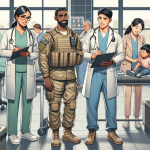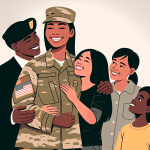Definition
A demonstration, in military terms, refers to an attack or show of force in one area designed to distract the enemy’s attention away from the real operational objective or area. It’s a tactical move intended to deceive the enemy, without necessarily seeking an encounter. However, it should appear as a credible threat to compel the enemy to disperse their resources or alter their strategies.
Key Takeaways
- A demonstration in military operations refers to an attack or show of force on a front where a decision is not sought, made with the aim of deceiving the enemy.
- It is a type of military deception, which has a longer duration than a feint. The objective is to cause the enemy to deploy their forces away from the actual target area.
- Demonstrations can occur in various forms including troop movements, noises or use of decoys. It is an valuable tactic in warfare for misleading the enemy about where the real attack will occur.
Importance
The military operations term, “Demonstration,” holds significant importance as a tactical subterfuge maneuver designed to deceive enemy forces.
The purpose of a demonstration is to feign an attack on a particular position, diverting the opponent’s attention and resources from actual objectives or drawing them into an unfavorable engagement.
By creating an illusion of intent, it allows the executing force to exploit the enemy’s vulnerabilities elsewhere, either by carrying out a surprise attack or advancing unopposed.
Consequently, a successful demonstration can be instrumental in achieving strategic and tactical superiority in military operations, making it an essential tool for military strategists and tacticians.
Explanation
The primary aim of a military operation termed as a “demonstration” is to distract or mislead the enemy about the true intent of a military action. Under this strategy, troops are ordered to demonstrate a significant show of force to deceive the enemy into thinking they are planning an attack.
Some of the tactics used during the demonstration could include a build-up of troops, mobilizing military equipment, or naval vessels at a particular location. The purpose is to cause the opponent to redirect resources and personnel to counter the perceived, but fabricated threat.
This misdirection can allow the actual attack or strategic move to have a greater chance of success since it’s likely to be encountering less resistance. The demonstration can cause opponents to reposition their defenses in the wrong place, or make them feel forced to respond in a certain, desired way.
Hence, a well-executed demonstration can have significant effects on the strategic outcomes of a military engagement without necessarily involving or resorting to overt aggression. Therefore, the tactic of demonstration is often adopted when military strategists seek to exploit an opponent’s vulnerabilities and shape their decision-making.
Examples of Demonstration
D-Day Invasion during World War II (June 6, 1944): Prior to the real invasion in Normandy, the Allies conducted a deception operation known as Operation Fortitude. They utilized a fictitious army group stationed in England and set up fake inflatable tanks, radio communications, and other false indicators to deceive the German defense into thinking the main invasion would take place at Pas de Calais.
Battle of Chu Lai during Vietnam War (1965): The United States Marine Corps landed at Chu Lai to establish a base station as a demonstration to both engage the Viet Cong and to send a signal to North Vietnam that the U.S. was prepared to increase its military presence in the war.
Operation Desert Saber during the Gulf War (1991): Before the ground invasion of Iraq, Coalition forces carried out an extensive aerial and naval bombardment for several weeks, aiming to destroy the Iraqi forces and infrastructure. This was a demonstration to the Iraqi forces of the sheer power, precision, and resourcefulness of the Coalition forces.
Frequently Asked Questions About Military Demonstration
1. What is a military demonstration?
A military demonstration refers to a show of military strength, tactics, or exercises displayed publicly to impress or to provide education about military capabilities. This can take the form of parades, simulated battles, or exhibition of weapons and cutting-edge technologies.
2. Why are military demonstrations conducted?
Military demonstrations are conducted for various reasons. They could be to boost morale among the troops, demonstrate capabilities to potential enemies, forge stronger alliance bonds with friendly nations or even provide the general public or select audiences with an understanding of military responsibilities and techniques.
3. Are there risks involved in conducting military demonstrations?
Yes, despite careful planning and training, there are inherent risks in all military operations, including demonstrations. This can range from accidents due to equipment malfunction or human error, to the risk of public protests against certain types of demonstrations.
4. Are military demonstrations useful for recruitment?
Yes, military demonstrations often spark interest among civilians in joining the military. They provide an opportunity to showcase the skills and comradery in the military, as well as the advanced technologies used, thereby attracting potential recruits.
5. Are public allowed to attend military demonstrations?
Depending on the nature of the demonstration, public may be allowed to attend. For events like parades or commemorative ceremonies, they’re usually open to the public. However, for demonstrations involving sensitive equipment or tactics, it is normally restricted to select military personnel, government officials, and invited guests.
Related Military Operation Terms
- VA Pilot Programs
- Benefit Eligibility Verification
- Veteran Service Application Process
- Vocational Rehabilitation Demonstrations
- Healthcare Delivery Model Test
Sources for More Information
- Encyclopedia Britannica: It is an online encyclopedia that provides hundreds of thousands of factual articles. Their military science category might have information about the term ‘Demonstration’.
- Joint Chiefs of Staff Official Website: The Joint Chiefs of Staff serves as the U.S. military’s primary body for communication, planning, and coordination. They might have relevant information or resources about ‘Demonstration’ on their website.
- United States Army Center of Military History: This organization could provide historical context about the use of ‘Demonstration’ in past military operations.
- U.S. Naval Institute: This is an independent, professional military association that could provide information on the term ‘Demonstration’ as well as additional military operations terms.
 Benefits.com Advisors
Benefits.com Advisors
With expertise spanning local, state, and federal benefit programs, our team is dedicated to guiding individuals towards the perfect program tailored to their unique circumstances.
Rise to the top with Peak Benefits!
Join our Peak Benefits Newsletter for the latest news, resources, and offers on all things government benefits.




















